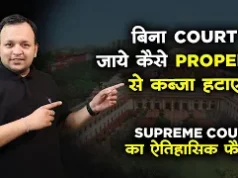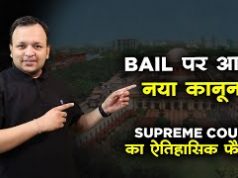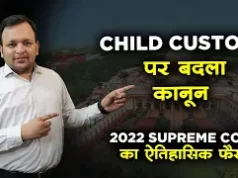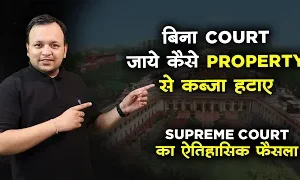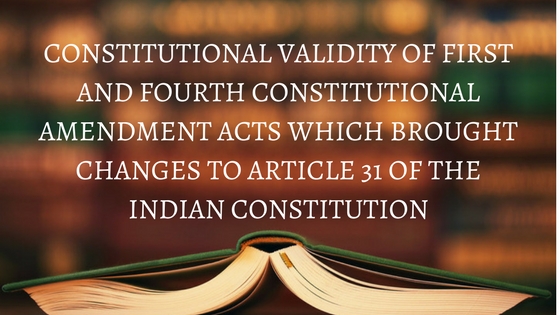
Aapka Consultant Judgment Series- In this series, we are providing case analysis of Landmark Judgments of Hon’ble Supreme Court of India.
Waman Rao and Ors Vs. Union of India (UOI) and Ors.
[1981] 2 SCR 1; (1981) 2 SCC 362
Hon’ble Judges/Coram: Y.V. Chandrachud, C.J., A.N. Sen, V.D. Tulzapurkar and V.R. Krishna Iyer, JJ., P.N. Bhagwati
Date of Decision: 13.11.1980
FACTS:-
A ceiling on agricultural holdings was imposed in Maharashtra by the Maharashtra Agricultural Lands (Ceiling on Holdings) Act 27 of 1961, which was brought into operation on January 26, 1962. The ceiling fixed by the Act (Principal Act) was lowered and certain other amendments were made to that Act by various amendments Acts. The validity of these Acts was challenged in the Bombay High Court and Supreme Court but was dismissed by the courts. The only point urged in these appeals was that the Principal Act, as amended, was void being violative of the second proviso to Article 31A(1), in so far as it created an artificial “family unit” and fixed the unit on the agricultural holdings on such family units. The Court rejected on the ground that even if the impugned provisions were violative of the second proviso they would receive the protection of Article 31B by reason of the inclusion of the Principal Act and the amending Acts in the Ninth Schedule. Therefore, the present appeal before this court.
ISSUE:-
Whether First Constitutional Amendment Act, 1951 which introduced Article 31A with retrospective effect and Section 3 of the Fourth Constitutional Amendment Act, 1955 are constitutionally valid or not?
JUDGMENT:-
The Agricultural Ceiling Acts, fall squarely within the terms of clause (a) of Article 31A(1). Those Acts provide for the extinguishment and modification of rights in an “estate”, the expression “estate” being defined by clause (2) (a) (iii) to mean “any land held or let for purposes of agriculture or for purposes ancillary thereto..”. It must follow, as a necessary corollary, that the impugned Acts are entitled to the protection of Article 31A(1)(a) with the result that their provisions cannot be deemed, and therefore cannot be declared, to be void on the ground that they are inconsistent with or take away or abridge any of the rights conferred by Articles 14, 19 or 31.
If a constitutional provision, which deprives the benefit and protection of Articles 14, 19 and 31 is invalid, the petitioners will be entitled to challenge the impugned laws on the ground that they are inconsistent with or that they take away or abridge the rights conferred by Part III of the Constitution. Article 13(2) has a sensitive touchstone. Not only does it mandate that the State shall not make any law which takes away or abridges the rights conferred by Part III but, it provides that any law made in contravention of the clause shall, to the extent of the contravention, be void. Mere abridgement, that is to say curtailment, and not necessarily abrogation that is to say total deprivation, is enough to produce the consequence provided for by Article 13(2).
Though the withdrawal of the application of Articles 14, 19 and 31 in respect of laws which fall under clause (a) is total and complete, that is to say, the application of those articles stands abrogated, not merely abridged, in respect of impugned enactments which indubitably fall within the ambit of clause (a), every case in which the protection of a fundamental right is withdrawn will not necessarily result in damaging or destroying the basic structure of the Constitution. The question as to whether the basic structure is damaged or destroyed in any given case would depend upon which particular Article of Part III is in issue and, whether what is withdrawn is quint-essential to the basic structure of the Constitution. The true position of law on the subject of Parliament’s power to amend the Constitution is that though the Parliament has the power to amend each and every Article of the Constitution including the provisions of Part III the amending power cannot be exercised so as to damage or destroy the basic structure of the Constitution as expounded in the case of H. H. Kesavananda Bharati v. State of Kerala, [1973] Supp. SCR 1.
If Article 31A were not enacted, some of the main purposes of the Constitution would have been delayed and eventually defeated and that by the First Amendment, the constitutional edifice was not impaired but strengthened. The First and the Fourth Amendments, especially the First were made so closely on the heels of the Constitution that they ought indeed to be considered as a part and parcel of the Constitution itself. These amendments are not born of second thoughts and they do not reflect a fresh look at the Constitution in order to deprive the people of the gains of the Constitution. They are in the truest sense of the phrase, a contemporary practical exposition of the Constitution. In order to effectuate the Article 39 of the Constitution, the First and the Fourth Amendments were passed. Article 31A(I) could easily have appeared in the original Constitution itself as an illustration of its basic philosophy. What remained to be done in the hope that vested interests will not distort the base of the Constitution, had to be undertaken with a sense of urgency and expediency. It is that sense and sensitivity which gave birth to the impugned amendment. The First Amendment there is discernible and nexus, direct and immediate to achieve the constitutional promises.
The provisions introduced by the First and the Fourth Amendment for the extinguishment or modification of rights in lands held or let for purposes of agriculture or for purposes ancillary thereto, strengthen rather than weaken the basic structure of the Constitution. The First Amendment is aimed at removing social and economic disparities in the agricultural sector. It may happen that while existing inequalities are being removed, new inequalities may arise marginally and incidentally. Such marginal and incidental inequalities cannot damage or destroy the basic structure of the Constitution. Thus, the adoption of “family unit” as the unit of application for the revised ceilings may cause incidental hardship to minor children and to unmarried daughters. That cannot, however, furnish an argument for assailing the impugned laws on the ground that they violate the guarantee of equality.
All amendments to the Constitution which were made before April 24, 1973 and by which the Ninth Schedule to the Constitution was amended from time to time by the inclusion of various Acts and Regulations therein are valid and constitutional. Amendments to the Constitution made on or after April 24, 1973 by which the Ninth Schedule to the Constitution was amended from time to time by the inclusion of various Acts and Regulation therein, are open to challenge on the ground that they, or any one or more of them, are beyond the constituent power of the Parliament since they damage the basic or essential features of the Constitution.
Article 31B provides that the Acts and Regulations specified in the Ninth Schedule shall not be deemed to be void or ever to have become void on the ground that they are inconsistent with or take away or abridge any of the rights conferred by Part III of the Constitution. The provisions of the Article are expressed to be without prejudice to the generality of the provisions in Article 31A and the concluding portion of the Article supersedes any judgment, decree or order of any court or tribunal to the contrary. This Article was introduced into the Constitution by section 5 of the Constitution (First Amendment) Act, 1951, Article 31A having been introduced by section 4 of the same Amendment. Article 31B has to be read along with the Ninth Schedule because it is only those Acts and Regulations which are put in that Schedule that can receive the protection of that article. The Ninth Schedule was added to the Constitution by section 14 of the First Amendment Act, 1951.
Article 31A protects laws of a defined category, Article 31B empowers the Parliament to include in the Ninth Schedule such laws as it considers fit and proper to include therein. The theory that the Parliament cannot exercise its amending power so as to damage or destroy the basic structure of the Constitution, was propounded and accepted for the first time in Kesavananda Bharati v State of Kerala, AIR1973SC1461. This is one reason for holding the laws incorporated into the Ninth Schedule before April 24,1973, on which date the judgment in Kesavananda Bharati was rendered. The second reason for drawing a line at a convenient and relevant point of time is that the first 66 items in the Ninth Schedule, which were inserted prior to the decision in Kesavananda Bharati, mostly pertains to laws of agrarian reforms. Article 31C of the Constitution, as it stood prior to its amendment by section 4 of the Constitution (Forty Second Amendment) Act, 1976, is valid to the extent to which its constitutionality was upheld in Kesavananda Bharati. Article 31C, as it stood prior to the Constitution (Forty Second Amendment) Act does not damage any of the basic or essential features of the Constitution or its basic structure. Once it is held that Article 31A is valid on its own merits, it must follow logically that the unamended Article 31C is also valid. The unamended portion of Article 31C is not like an unchartered ship. It gives protection to a defined and limited category of laws which are passed for giving effect to the policy of the State towards securing the principles specified in clause (b) or clause (c) of Article 39. It is impossible to conceive that any law passed for such a purpose can at all violate Article 14 or Article 19. In fact, far from damaging the basic structure of the Constitution, laws passed truly and bona fide for giving effect to directive principles contained in clause (b) and (c) of Article 39 will fortify that structure.
HELD:-
The Constitution (First Amendment) Act, 1951 which introduced Article 31A into the Constitution with retrospective effect and sec. 3 of the Constitution (Fourth Amendment) Act, 1955 which substituted a new clause (1), sub-clauses (a) to (e) for the original clause (1) with retrospective effect, do not damage any of the basic or essential features of the Constitution or its basic structure and are valid and constitutional being within the constituent power of the Parliament.
To Get Legal Opinion from Advocates/ Legal Experts, Please click here
To Get Legal Opinion from Retired Hon’ble Judges, Please click here



